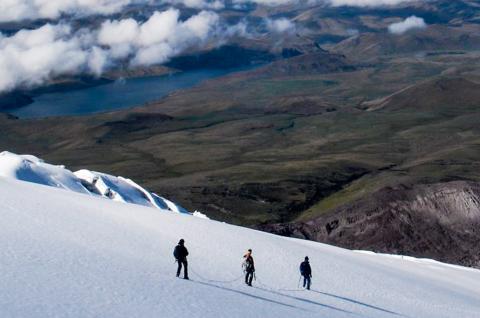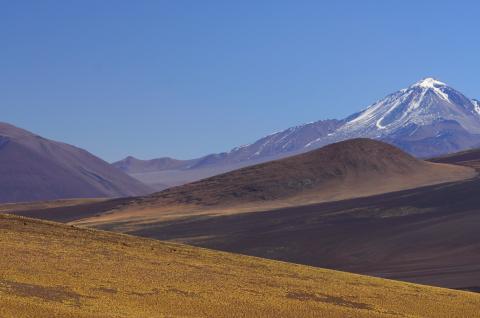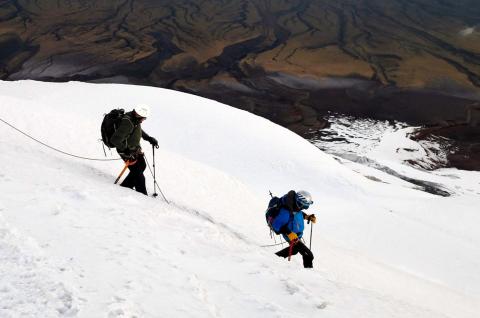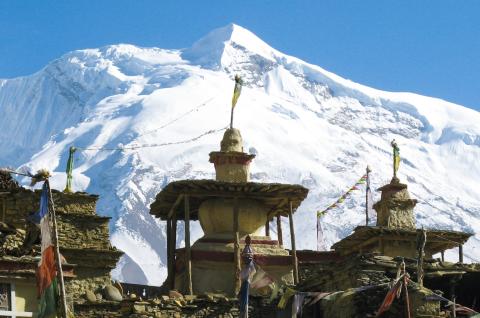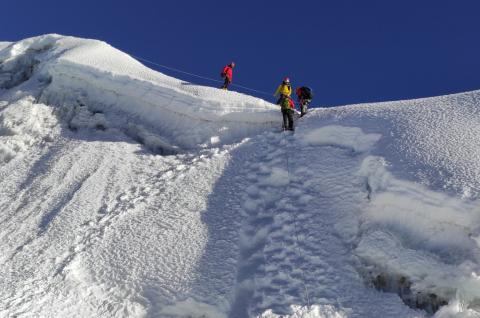One of the 7 toughest summits
Highlights
- One of the 7 most difficult Summits
- Magnificent Denali National Park
- Ratio 1 guide for 2 participants
- Preparation, medical and weather course included
- H24 Ifremmont medical hotline
- Live coverage of the expedition for your community
- A human adventure in a very small group
Denali, the highest mountain in America, is unmatched in terms of technical challenges and scenic beauty. Located 210 kilometres north of Anchorage, Alaska, it rises above a sea of glaciers and other peaks that make up the Alaska Range. Through our preparation and the constitution of our group, we offer experienced mountaineers a solid chance to achieve their goals. We take the classic West Buttress Route. We start at the base camp in Denali National Park and Reserve where we were dropped off by private plane, then climb nearly 4000 meters to reach the summit. Skiing instead of snowshoes is an option to discuss with the group. The biggest challenge is the weather, which means that a few days of contingency are needed.
Overview
Find here images of the ascent of Denali at 6190 meters by Eric Bonnem.
We offer an expedition to the summit of Mount Denali, formerly Mac Kinley, culminating at 6190 meters in Alaska’s Denali National Park.
We climb the West Buttress by providing relays for loads, setting up camps and climbing slowly enough for proper acclimation. Be careful, you must bring your personal belongings and your share of the collective equipment.
The latitude and geographical position of Mount Denali have two major impacts on its difficulty: bad weather and cold on the one hand, atmospheric pressure, on the other hand, less important towards the poles than at the equator. As a result, the 6190 meters of altitude of Denali can be compared from a hypoxic point of view to 6500/ 6700 meters in the Himalayas.
We have planned many days of contingency to overcome bad weather, always possible, to fly to the glacier or to progress in the altitude camps. You may have completed the expedition well before the theoretical end of this program. You can then take the opportunity to visit Alaska freely or advance your flight to return to Europe. Neither is included in the price of this package.
For those of you who are at the right level, we do part of the route in ski touring up to 4300 meters. Above it is steep slope skiing. The advantage is that for the descent, you can make the return faster without it being too difficult. The other advantage is that, if the glacier is open, there is less risk of ski crevasses compared to walking and snowshoeing. Expected ski level: you have to know how to ski in all kinds of snow and, ideally, have enough light equipment because we must pull the pulkas.
Find here the animated route of the ascent of the Denali at 6190 meters.
The main objective of this expedition is to experience an adventure that requires total commitment, both physical and moral, acting with lucidity and humility in a hostile natural environment that forgives no imprudence or temerity at the risk of death. It is this testimony that must be wisely recounted.
To move at high altitude requires careful preparation, adequate acclimatization, permanent and mutual verification, constant intellectual vigilance, immediate renunciation in case of weakness, doubt or danger.
Good observance of all safety rules is essential, as is good physical and psychological preparation, a warm and supportive environment, total serenity, a little tactics and then, if the weather is kind and luck is on our side, we will be able to count down the magic minutes at the summit when effort ceases and nothingness fills the space and instills itself within us.
All parties agree that giving up does not constitute failure. Returning can also be a victory over oneself. Any preparation, even the most meticulous, any will, even the most tenacious, can be defeated by the adversity of natural environments whose strength is exponentially stronger than the finest human intelligence.
OUR MOTTO IS: DARE TO CLIMB, KNOW HOW TO DESCEND
Itinerary
Day 0
EXPEDITION SUMMARY PROGRAM
- Days 1 & 2: International flights to Anchorage
- Day 3: Transfer to Talkeetna
- Day 4: Flight to Kahiltna Glacier
- Days 5 to 19: Ascension of the Denali (15 days)
- Day 20: Flight back to Talkeetna
- Days 21 & 22: Transfer to Anchorage and take off for Europe
- Day 23: Landing in Europe
EXPEDITION DETAILED PROGRAM
Days 1 & 2: International flight and arrival in Anchorage
Day 1
Most flights from Europe arrive in Anchorage on day 2.
Day 3: Transfer to Talkeetna
Day 3
We leave by taxi for Talkeetna where we settle in a hotel. Some paperwork to be completed, including collecting our climbing permits from the park rangers and confirming our flights to the Kahiltna glacier. We are preparing our bags for the flight. We still have time to buy or rent individual or collective equipment, to prepare our rations for our meals that will be taken in the mountains.
Day 4: Flight to Kahiltna Glacier
Day 4
As soon as the weather gives us a window, we fly from Talkeetna airport to the glacier of Kahiltna 90 kilometers away. We are at base camp.
Days 5 to 19: Ascent of Mount Denali (6190 m)
Day 5
We will devote about twenty days to the ascent of Denali with many contingency days to take into account the weather.
IN SUMMARY
We cover the first 9 kilometres of the route on the Kahiltna glacier up to 3350 metres in snowshoes (or skiing according to the option chosen with our expedition leader), which helps us to move efficiently in deep snow conditions and on variable terrain with our heavy loads and pulkas. We usually place three camps on this section of the route. Above 3350 meters, the terrain becomes stiff and we move to crampons. Our next camp is located at 4350 meters, located in a large basin relatively sheltered from the strong winds with breathtaking views of Mount Hunter and Mount Foraker. After 4 to 5 days of acclimatization, during which we review the techniques and carry the loads to 4950 meters, we leave for high altitude. Between 4550 and 4950 meters, the slopes have a gradient of 40 to 45 degrees, so we climb safely on fixed rope.
We may camp at the top of the fixed ropes at 4950 meters to cut off the climb or if we have to wait for better weather. The next 300 meters of ascent on the narrow ridge and granite rocks to the high camp at 5250 meters are a picturesque and memorable part of the route. The day after is usually devoted to rest and acclimatization, but if we are sufficiently rested and the weather lends itself to it, we continue and try the summit.
The day of the summit usually lasts 10 to 14 hours. After the summit, it usually takes 2 days to return to base camp from the altitude camp.
IN DETAIL
The expedition leader is responsible for taking into account all parameters (weather, terrain conditions, temperature, shape and shape of participants, etc.) to define the appropriate climbing strategy with the group. To allow you to project yourself, here is a typical ascent program, for example:
Day 5: From base camp (2200 m) to Camp 1 (2380 m)
Distance: 8 km, elevation gain: 180 m.
Night at 2380 m.
Day 6: Carrying to Kahiltna Pass (2960 m) then back to Camp 1
Distance: 8 km (return), elevation gain: 580 m/ elevation gain: 580 m.
Night at 2380 m.
Day 7: Climb to Camp 2 (3350 m)
Distance: 7 km, elevation gain: 970 m.
Night at 3350 m.
Day 8: Carrying to Kahiltna Pass (2960 m) and return, then back to Camp 2 (3350 m)
Distance: 2 km (return), elevation gain: 390 m/ elevation loss: 390 m.
Night at 3350 m.
Day 9: Carrying to Windy Corner (4110 m) and return to Camp 2 (3350 m)
Distance: 6 km (return), elevation gain: 760 m/ elevation loss: 760 m.
Night at 3350 m.
Day 10: Climb to Camp 3 (4330 m)
Distance: 4 km, elevation gain: 980 m.
Night at 4330 m.
Day 11: Return to Windy Corner and carrying to Camp 3 (4330 m)
Distance: 3 km (return), elevation gain: 220 m/ elevation loss: 220 m.
Night at 4330 m.
Day 12: Rest and acclimatization Camp 3 (4330 m)
Day 13: Carrying to 4940 m (hide above the headwall) or Camp 4 (5240 m) and back to Camp 3 (4330 m)
Distance: 3 km (return), elevation gain: 610 m/ elevation loss: 610 m.
Night at 4330 m.
Day 14: Rest/ acclimatization/ Weather contingency day at Camp 3 (4330 m)
Night at 4330 m.
Day 15: Climb to Camp 4 (5240 m)
Distance: 3 km, elevation gain: 910 m.
Night at 5240 m.
Day 16: Summit push (6190 m)
Distance: 8 km (return), elevation gain: 950 m/ elevation loss: 950 m.
Night at 5240 m.
Day 17: Weather contingency day
Day 18: Return to Camp 3 (4330 m)
Distance: 3 km, elevation loss: 910 m.
Night at 4330 m.
Day 19: Return to base camp (2200 m)
Distance: 20 km, elevation loss: 2130 m.
Day 23: Return flight to Talkeetna
Day 23
We take our return flight from the glacier to the airport of Talkeetna, as soon as the weather allows us.
Day 24: Transfer to Anchorage then flight to Europe
Day 24
We take a taxi back to Anchorage and then fly back to Europe.
Day 25: Arrival in Europe
Day 25
END OF EXPEDITION
For reasons that cannot be foreseen at this stage, such as unpredictable weather, the physical fitness or lack of fitness of participants or other circumstancess (customs formalities, road conditions, traffic, landslides, force majeure, etc.), your expedition leader may have to adapt the program, if necessary, to ensure the smooth running of your trip. He remains the sole judge and the one who guarantees your safety. Activity times are given as an indication and may vary from one participant to another.
The itinerary for all our expedition programs, or the ascent program for our high-mountain expeditions, are given here as a guide only. They are flexible enough to adapt to weather conditions with a few contingency days. In any case, you should follow the recommendations of your guide, who may suggest that you cancel your expedition due to weather, safety or physical conditions.
It is important to remember that this is a truly unsupported expedition, and that anything can happen. Expeditions Unlimited, your expedition leader, your guide or our local teams can in no way be held responsible.
Any costs incurred as a result of a change in the expedition schedule (extra nights' accommodation, extra flights) will be borne by the participants and not by the organizers. "Contingency days" refer to the expedition in the strict sense of the term (base camp/base camp in the mountains, departure point/exit point on a traverse, etc.).
Any early return of the expedition or of certain members only (early success, abandonment, etc.), generating costs for accommodation, meals, changes to air tickets or other activities not provided for in this program, will be charged in full to the participants.
Trip notes
Guiding
Services within Denali National Park are provided by authorized concessionaire IMG Denali, LLC.
We plan a team of mostly American mountain guides, experienced on the mountain, with a ratio of 1 guide to 2 mountaineers. The group will be international in structure and the general language of exchanges will be English. We plan to have a French speaking guide among our support team (to be confirmed when you register).
During the whole expedition we are active and mobilized in setting up camps, preparing meals, etc. We take our personal belongings, food and some of the collective equipment into our pulka which should weigh around 60 kg.
And throughout the program, we will draw on other local expertise as needed. Finally, we will have access to experienced weather forecast services and a doctor specialized in the high altitude of Ifremmont (see above).
For unpredictable reasons at this stage, like adverse weather conditions, insufficient physical condition of participants, insufficient competencies of participants related to the intended activities, your guide may decide to adjust the intended program and/or activities. At all times, his decision will be final on all matters likely to affect the safety and well-being of the trip.
Difficulty level
Level rated: difficult
This program is aimed at participants in good physical shape, with a significant sport practice, endurance in particular, holding a strong mental to face difficulties that are unforeseen by nature.
The Denali is given as “difficult” given the conditions in which you will be operating. The latitude and geographical position of Mount Denali have two major impacts on its difficulty: bad weather and cold on the one hand, the atmospheric pressure, on the other hand, less important towards the poles than at the equator. As a result, the 6190 meters of altitude of Denali can be compared from a hypoxic point of view to 6500/ 6700 meters in the Himalayas.
This expedition is therefore designed for experienced mountaineers with a good knowledge of very high altitudes. It is essential to be totally self-sufficient in the mountains, both technically and psychologically. The expedition leader and altitudes guides are primarily technical advisors and logistics managers. Under no circumstances can they "pull" a participant towards the summit.
Rigorous training is of course essential, focusing on developing endurance and stamina: running, cycling, swimming, cross-country skiing and, of course, mountain climbing. This training must be regular and begin at least 6 to 8 months before the start of the expedition.
For a relatively long period of time, the body will be subjected to considerable physical effort in a difficult environment, with the added handicap of high altitude. Serious physical preparation is essential for an expedition of this scale: you will need to work on your stamina and endurance, even in difficult climatic conditions (cold, wind).
Beware of carrying: in Alaska, there is no carrying like in Nepal or anywhere else in the world. The participants carry their own individual equipment and collective equipment. Pulkas are used in the first part of the expedition, and then back and forth between camps take over to reduce the load on each trip. This approach also allows for good acclimatization. Count about sixty kilos in the pulka, then 8 to 15 kilos in the backpack, higher up.
On an expedition, participants are confronted with a hostile environment due to its remoteness, cold, bad weather and discomfort, all of which can generate stress. Fatigue can be the cause of mood and relationship disorders. Everyone must therefore show good mood, tolerance and respect, not only towards the members of the expedition, but also towards the local team. The group may split into sub-groups according to individual affinities. Keep in mind that it is the core team that prevails and that, as always in this type of project, the key to success remains the collective and team spirit.
We offer a preparation for the expedition that takes place over several days:
- a theoretical day where we will go through the main stages of the expedition and answer all your questions;
- a day of practice to review the basics with one of our experienced mountain guides;
- If the schedule allows, we offer medical training at high altitude with the Ifremmont.
To register for this expedition, you will be asked to provide an expedition (mountain climb list)/trek/athlete CV. A hypoxic stress medical test is also mandatory, as is a medical certificate for completing an ascent in the Himalayas.
You benefit, free of charge and for the duration of your expedition, from membership in the 24/7 high altitude medical service set up with our partner Ifremmont, of which we are partners. See below.
Technical difficulty
Mountaineering level: PD like... A little difficult (Peu Difficile in French)
In this programme, the use of mountaineering equipment (crampons, harnesses, ice axes, ropes, etc.) is necessary and the route covered involves difficulties, whether it is a little more inclined passage during glacier mountaineering, the height of the wall, the commitment of the climb and the continuity of efforts. Between 4550 and 4950 meters, the slopes have a gradient of 40 to 45 degrees and we climb safely on a fixed rope. It is therefore aimed at climbers who have already completed ascents of this level.
And this technical rating applies of course to normal weather conditions: the difficulty can increase in case of bad conditions, fresh snow on rocks, insufficient or lack of ice quality, etc.
Similarly, the situation changes radically for the same technical level with altitude, bag weight, lack of route equipment on site, fatigue due to approach if it is long, particularly hostile environment, etc.
We can build a climbing training course for you as part of our Adventure School.
Meeting point
We are met at Anchorage airport by our local staff and driven to our hotel. For international transport, regular economy class flights on the following airlines: Air France, United Airlines, Delta Airlines, etc.
Given the diverse origins of the participants on this trip, international outward and return flights are not included in this package. In most cases, we book flights on your behalf to ensure that the whole group arrives at the destination at the same time. We do not charge any fees for these air bookings. Please do not hesitate to contact us. If you book your own tickets, we will advise you on the ideal flight schedule to enable all participants to arrive within a reduced time frame. At the very least, you need tickets that can be modified.
Accommodations
Single room in a standard hotel in Anchorage and in a standard hotel, flat or house in Talkeetna. In total, 3 nights in hard accommodation are covered in this package including 2 nights in Anchorage and 1 night in Talkeetna. Any time lag, weather-related delays requiring additional nights at the hotel will be covered by the participant. The room is shared between the members of the expedition.
During the climb, a 2-person high altitude tent for logistical (weight) and safety reasons (to monitor each other). It is shared among the members of the expedition.
Meals
In the cities, many restaurants allow us to discover typical American cuisine. No meals in Anchorage or Talkketna are covered in this package to allow for the maximum amount of flexibility.
During the expedition, meals are offered in the form of freeze-dried rations. These rations contain, among other things, coffee and tea, cereals, mashed potatoes, soup, broths, Chinese pasta, freeze-dried dishes, snacks, etc.
Add hydration tablets that provide essential minerals in a long expedition where the water will be exclusively melt water. They provide you with essential minerals (sodium, potassium, magnesium, calcium) to compensate for losses caused by sweating, vitamins B2, B6, B12 that participate in the production of energy and vitamin C which has an antioxidant role and helps fight fatigue.
Transfers / Transport
Transfers are provided in privatized vehicle.
Group size
The group is composed of 4 to 8 participants maximum. The number of participants is deliberately limited to allow for greater immersion, to avoid embarrassing our hosts, and to develop freedom and flexibility. However, the maximum number may be exceeded if the last person to register wishes to travel with one or more other people. The services will not be modified, and the conditions of the trip will remain the same.
Equipment
Personal equipment is not provided. A complete list is provided to ensure you are taking what is needed.
Logistics equipment is provided, kitchen equipment (stove, gas, etc.) and bivouac (two-seater tent).
Our commitments to sustainable development
Our commitment to a better planet has been a reality since the beginning of our story but we always need to do more and better. Please find out more about our charter and our commitments in terms of sustainable development. We have drafted our charter and take action through six themes on which we act as concretely as possible, most often with you: social equity and cultural respect, preservation of water, waste management in expedition, protection of biodiversity, raise public awareness on these subjects and finally, the optimization and recovery of CO2 emissions.
Regarding carbon emissions, most of which are due to air travel, we calculated and communicated in 2018 on the carbon footprint of each of our programs, expressed in tonnes of CO2.
These calculations made us aware of the importance of the total carbon emissions generated by our activity. Also, we have committed in 2022 to a carbon reduction that we believe is unprecedented in the tourism industry, aiming to reduce the total emissions of our activity by 5% per year, taking 2019 as the reference year (3,430 tonnes of CO2). This commitment is in line with the trajectory of the Paris climate agreements of 2015, the current benchmark. Thus, in 2030, we commit ourselves not to exceed 2,160 tonnes of C02. Thus, our maximum “carbon” budget for 2024 is 2,950 tonnes and for 2025, this budget will be reduced to 2,800 tonnes. And so on until 2030. To find out more about all of our calculations and our commitments in terms of reducing our carbon emissions.
In addition, since 2019, we have been encouraging you when you book for your journey to contribute with a donation to an independent NGO, among the two we have selected that share the commitments made in our charter. We matched the amount of this donation to this program's carbon footprint. Thus, the journey you are considering generates 3,91 tons of CO2, which corresponds to a 100% donation of €117 for an estimated value today of €30 per tonne of CO2. This donation remains of course optional and you can decide to give between nothing and 100% of this amount. Since 2019, including covid years of 2020 and 2021, we have been able to collect thanks to you nearly €7,000 for these associations.
Please do not hesitate to come back to us with any questions you might have regarding this carbon footprint mechanism, our other sustainable développement commitments or even to share with us your experience through a chat or a mail at contact@secret-planet.com.
Expert
I love this peak between mountaineering and the polar world, which I was lucky enough to climb with friends a few years ago. Alaska is a land of incredible adventure, and just arriving in Anchorage, transferring to Talkeetna and then flying onto the glacier are highlights. Then, on the mountain, the challenge is the size of the monster, rather debonair when the weather is favorable, inaccessible for the common mortal otherwise. Incredible nature, a more professional atmosphere than on many of the world's mountains. You'll come across some strong mountaineers. The logistical stakes are high if you decide to organize it yourself, and the weight of the pulka, nearly 100 kilos, is commensurate. It's an extraordinary expedition that, under American regulations, we are obliged to organize with American partners, whom we choose carefully. Our role is to brief you in detail, to prepare you mentally, physically and logistically, and to settle the final preparations down to the last detail, so that you can leave with peace of mind.
Departures and pricing
Please find below all dates and prices for this expedition. Prices are quoted "from" and may be adjusted notably according to the number of participants (see trip notes for details). Please note that dates and prices for years beyond 2024, when given, are for guidance only and are subject to change and readjustment to take account of current economic realities.
No date works for me!
I initiate a new datePrice includes
- Hotel nights 3/4 stars (***) in Anchorage (2 nights) and Talkeetna (1 night) with breakfast, room or flat sharing for up to three nights
- Airport/hotel transfers and Anchorage/Talkeetna transfer
- Meals in lyophilized rations (breakfast, dinner) during the expedition (base camp/ base camp)
- 1 experienced American expedition leader per group
- 1 mountain guide for 2 or 3 participants, depending on the year
- High altitude tents, high altitude food, stoves and fuel
- Collective equipment needed for the ascent (fixed ropes, mooring)
- Satellite phone and security equipment (only for emergency services)
- Experienced weather forecast services
- Medical follow-up by the Ifremmont during the expedition (see above)
- Preparation days (theoretical, practical, medical)
- Live expedition coverage for your community (providing InReach tag, IridiumGo and subscriptions, LivExplorer configuration service)
Price does not include
- International flight to/from.Consular fees (visa)
- Any customs taxes on arrival in the USA
- Any additional hotel nights (beyond 3 nights)
- Taxes and climbing permits, fixed rope fees and other government taxes (440 US$ in 2025 to be paid in Talkeetna)
- Expenses related to a shift in the expedition schedule (extra nights' accommodation and meals, additional airfares)
- Expenses related to an early return of the expedition or only certain members (early success, abandonment, etc.), generating costs for accommodation, meals, modification of air tickets or other activities not provided for in this program
- Meals outside of the expedition other than three breakfasts at the hotel
- Tips for the guide, to be shared with other participants to your satisfaction
- Any personal communications by satellite telephone (to be paid on site)
- Pre-acclimatization protocol developed with the Ifremmont and Sport Altitude (customization, advice, follow-up, material) as described above
- Any taxes on the importation of satellite telephones, professional communications equipment and commercial film shooting
- Personal equipment including individual high mountain equipment
- Drinks and all personal expenses (personal visits, taxis, souvenirs, dry cleaning...)
- Travel and shipping insurance (assistance, evacuation and repatriation)
- Expenses incurred in the city due to an early return (see end of programme)
Your custom expedition
We put our expertise, our knowledge of the terrain, our creativity, our experience, the quality of our guides and the reliability of our partners at your service to build your custom expedition. We can also personalize an expedition to your wishes as soon as you form a "closed" group, whatever the number of participants.
This means that, unless you authorize us to do otherwise, no outside participants join you, and we can personalize your expedition by adapting it to your own pace, with the program extensions you desire, a higher level of comfort, certain activities, other encounters, etc.
Every expedition of this type is subject to a specific quotation. To get in touch with us now, please fill in the short questionnaire below. One of our experts will get back to you to refine your request and make you a proposal.





























